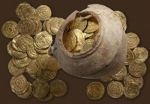(Press-News.org) EAST LANSING, Mich. — The secret to the deadly 2011 E. coli outbreak in Germany has been decoded, thanks to research conducted at Michigan State University.
The deadliest E. coli outbreak ever, which caused 54 deaths and sickened more than 3,800 people, was traced to a particularly virulent strain that researchers had never seen in an outbreak before. In the current issue of the academic journal PLoS ONE, a team of researchers led by Shannon Manning, MSU molecular biologist and epidemiologist, suggests a way to potentially tame the killer bacteria.
The strain, E. coli O104:H4, shares some characteristics as other deadly E. coli bacteria, but its combination is novel. Researchers haven't determined the mechanism it uses to cause disease, although Manning and her team were able to find the strain's Achilles heel – its biofilm.
By focusing on the bacteria's biofilm, the grouping of many E. coli bacteria that stick to a cell's surface and grow encased in a self-produced protective coat, Manning and colleagues were able to determine why it was so deadly. When the bacterium found in Germany forms a biofilm, it begins to make more toxic genes like the Shiga toxin.
Increased production of the Shiga toxin is the probable culprit that contributed to so many incidents of kidney damage and death during the 2011 outbreak, Manning said.
"What made the German outbreak so different is that many victims suffering from kidney failure were adults," she said. "Rather than attacking adults, other types of E. coli that produce Shiga toxins typically damage kidneys of children under 10."
In addition, the incubation period was considerably longer among individuals infected with the German outbreak strain compared to individuals infected with E. coli O157, a similar bacterium that can also cause illness and death. Manning believes this is because the German strain needs a longer period of time to form a biofilm, whereas biofilms are not important for O157 infections.
"Our research demonstrates that biofilm formation is critical for toxin production and kidney damage," she said. "If we can block the bacteria from forming a stable biofilm, then it is likely that we can prevent future E. coli O104:H4 infections."
The next phase of Manning's research is already focusing on creating mutant strains in an effort to prevent the bacterium from forming a biofilm. This would prevent the disease completely since the conditions would not be favorable for bacterial growth.
###Chris Waters, MSU assistant professor of microbiology and molecular genetics, and scientists from the University of Michigan and the Michigan Department of Community Health contributed to the research.
Manning's research was funded in part by the National Institutes of Health (U19AI090872), the U.S. Department of Agriculture and MSU AgBioResearch.
Michigan State University has been working to advance the common good in uncommon ways for more than 150 years. One of the top research universities in the world, MSU focuses its vast resources on creating solutions to some of the world's most pressing challenges, while providing life-changing opportunities to a diverse and inclusive academic community through more than 200 programs of study in 17 degree-granting colleges.
Deadly E. coli strain decoded
2012-07-26
ELSE PRESS RELEASES FROM THIS DATE:
'Basarab' surname may not indicate direct relation to Vlad the Impaler
2012-07-26
WASHINGTON—A study by the Genographic Project has shown that not all individuals carrying the Romanian "Basarab" surname, the first dynasty of Wallachian kings that included the real-life Dracula, can be direct biological descendants of the Basarab dynasty.
The Basarab dynasty ruled Wallachia, the historical and geographical southern region of present-day Romania, for almost three centuries (1330-1601) and had among its members Vlad III the Impaler, commonly known as Dracula. The ethnic origin of the Basarab family has long been a dispute among historians, with both an ...
Should high-dose interleukin-2 continue to be the treatment of choice for metastatic melanoma?
2012-07-26
New Rochelle, NY, July 26, 2012— Administering high-doses of interleukin-2 (IL-2) has been the preferred treatment for patients with stage IV metastatic melanoma. An article published in the current issue of Cancer Biotherapy and Radiopharmaceuticals, a peer-reviewed journal from Mary Ann Liebert, Inc. (http://www.liebertpub.com), explores whether or not this regimen is still the most effective. The article is available free online at the Cancer Biotherapy and Radiopharmaceuticals website (http://www.liebertpub.com/cbr).
In the article "Should High-Dose Interleukin-2 ...
Toddlers object when people break the rules
2012-07-26
We all know that, for the most part, it's wrong to kill other people, it's inappropriate to wear jeans to bed, and we shouldn't ignore people when they are talking to us. We know these things because we're bonded to others through social norms – we tend to do things the same way people around us do them and, most importantly, the way in which they expect us to do them.
Social norms act as the glue that helps to govern social institutions and hold humans societies together, but how do we acquire these norms in the first place?
In a new article published in the August ...
Robotic surgery outcomes data presented at head and neck cancer annual meeting
2012-07-26
Predictors of disease severity in human papillomavirus-derived head and neck cancer, tobacco use, and the dramatic benefits of robotic surgery in people with head and neck cancer are among landmark research presented by Mount Sinai School of Medicine at the Eighth International Conference on Head and Neck Cancer. The meeting took place from July 21-25, 2012 in Toronto.
Highlights of Mount Sinai research at the American Head and Neck Society conference:
Transoral Robotic Surgery Shows Significant Promise in Hard-to-Treat Smokers with Head and Neck Cancer
In a retrospective ...
Hoard of Crusader gold found in ruins
2012-07-26
A team of researchers from Tel Aviv University has uncovered a hoard of real-life buried treasure at the Crusader castle of Arsur (also known as Apollonia), a stronghold located between the ancient ports of Jaffa and Caesarea, in use from 1241 to its destruction in 1265. The hoard, comprised of 108 gold coins, mostly dinars dated to the Fatimid Period (ca. 900 to 1100 AD), was discovered in a pot by a university student. The coins bear the names of sultans and blessings, and usually include a date and a mint name that indicates where a coin was struck.
This fascinating ...
VCU medical team recommends preventive antibiotic for COPD sufferers
2012-07-26
RICHMOND, Va. (July 26, 2012) – Patients suffering from the chronic lung condition COPD, which is the third-leading cause of death and disability in the United States, may benefit greatly from a three-times-a-week dose of an antibiotic, according to a study by Virginia Commonwealth University physicians published in today's issue of the New England Journal of Medicine.
Approximately 24 million Americans suffer from COPD, or chronic obstructive pulmonary disease, which creates recurrent, acute episodes of severe shortness of breath, cough and sputum production. Every ...
Environmental groups should pool efforts to reach the public
2012-07-26
URBANA – A lot of time, effort, and money are spent by agencies, municipalities, and other non-governmental organizations to inform and educate the public about environmental concerns. Could these groups collaborate to inform the public about an environmental concern even though their beliefs may be very different? Two studies suggest that they can and should.
University of Illinois professional geographer Bethany Cutts tracked messages to the public about water quality and usage from a variety of sources in Phoenix, Arizona. She found that considerable overlap in the ...
No LOL matter: Tween texting may lead to poor grammar skills
2012-07-26
University Park, Pa. -- Text messaging may offer tweens a quick way to send notes to friends and family, but it could lead to declining language and grammar skills, according to researchers.
Tweens who frequently use language adaptations -- techspeak -- when they text performed poorly on a grammar test, said Drew Cingel, a former undergraduate student in communications, Penn State, and currently a doctoral candidate in media, technology and society, Northwestern University.
When tweens write in techspeak, they often use shortcuts, such as homophones, omissions of non-essential ...
NIST measurement advance could speed innovation in solar devices
2012-07-26
A new versatile measurement system devised by researchers at the National Institute of Standards and Technology (NIST) accurately and quickly measures the electric power output of solar energy devices, capabilities useful to researchers and manufacturers working to develop and make next-generation solar energy cells.
Innovative devices that convert sunlight to electric power more efficiently and cost effectively than the current generation of solar cell technology are the objects of a global pursuit—means to reducing fossil-fuel consumption and to securing pole position ...
Ion selectivity in neuronal signaling channels evolved twice in animals
2012-07-26
This press release is available in German.
Excitation of neurons depends on the selected influx of certain ions, namely sodium, calcium and potassium through specific channels. Obviously, these channels were crucial for the evolution of nervous systems in animals. How such channels could have evolved their selectivity has been a puzzle until now. Yehu Moran and Ulrich Technau from the University of Vienna together with Scientists from Tel Aviv University and the Woods Hole Oceanographic Institution (USA) have now revealed that voltage-gated sodium channels, which ...



